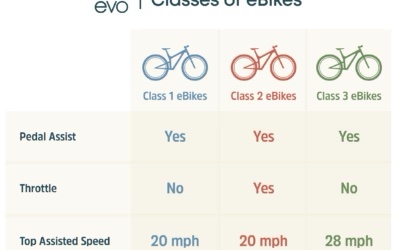What is the 3-class system?

If you are reading this, you probably know a little about E-bikes. You have likely gotten a lot of misleading information too. The world of E-bikes is a confusing one with lots of conflicting standards and options, so you could be forgiven if you really can’t figure out what the truth is sometimes. If that sounds like you, then this is the guide for you. First off, what IS the 3 class system anyways, and where did it come from?
Back in the olden days, the electric bike market was like the wild west. People were making all sorts of contraptions, some safe, some not. Some fast, some not. It turns out that the government doesn’t like people riding these things that allowed them to go fast, sorta like a motorcycle, but not quite. People were sometimes found cruising down highways without a helmet or a license but getting away with it, or not, by claiming it was just a bicycle. Some people found themselves on off-road trails going far too fast for the intended design. Naturally, something had to be done.
In 2014 there was a meeting of the minds. Among other organizations, People for Bikes is largely credited with creating the 3-class system to help governments decide which type of electric bike they should allow on what sort of infrastructure. It was just a way to say who was who. Manufacturers could slap a label on it, and now that label tells more than just a marketing term. That label carries with it both a physical implication of what the machine can and will do as well as a legal implication of where you might be able to ride it.
So that’s the back story. Now, what are those three classes? Here is the short answer:
Class 1 – Pedal assist up to 20 mph, no throttle
Class 2 – Pedal assist up to 20mph, Throttle assist up to 20 mph
Class 3 – Pedal assist up to 28mph, No throttle
Now, why would there be this weird distinction? You may hear something about power outputs and wattage, but the truth is, these classes were defined by their intended use. For better or for worse, it was decided that most governments simply would never allow a pedal-assisted mountain bike on their trails that was able to go just any speed, and the idea of a throttle sounded just a little too much like a motorcycle. That is where Class 1 came in. Unless your state has specific restrictions, any bike with a pedal-assist under 20mph with no throttle can go just about anywhere a regular bike is allowed to go. Please be careful with this tho as some trail systems still do not allow pedal-assist bikes. Respect the local laws.
What happens if you add a throttle? Well, as long as it is used in safe areas, you should be fine. Generally, these are restricted to road and sidewalk use only. Class 2 is for the commuter who is not really into bikes but wants to get from place to place, perhaps while carrying a cart full of groceries. Generally, you will find comfort bikes, beach cruisers, and hybrids in the class 2 category. While they certainly exist, other types of bikes are less common in this classification.
So now we have a class for the off-road junkies and the ones who just want to get around town, but there’s another crowd that likes to go fast with a bit of acceleration. At some point, it has to be called a motorcycle, even if it is just a pedal-assist, so a line had to be drawn. 28mph is what the USA agreement has come to. Anything under that limit, you’re alright. Anything over, and well, it depends on where you are riding as to how it will be assessed. So if you really want to get out on the road and go for long distances at higher speeds, you need a class three. These bikes go faster, tend to have larger batteries and larger motors than the other two classes, and tend to come with nicer technology.
Remember, these classes were designed so that governments could better understand the system, and bike manufacturers would have a guide to go on for what works and what doesn’t. There are many electric bikes out there that do not fall into any of the three classes listed here. Some electric bikes will go over 100mph. Some will max out at about 15. Just remember to check state and local laws concerning electric bike usage wherever you ride. But remember, always have fun!
